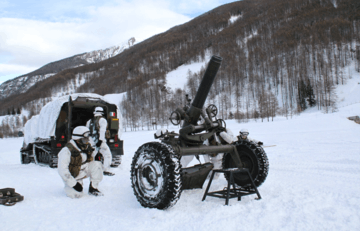2nd Alpini Regiment
| 2° Reggimento Alpini | |
|---|---|
 Coat of Arms of the 2nd Alpini Regiment | |
| Active |
1 Nov. 1882 – 8 Sept. 1943 1 July 1963 – 31 October 1974 28 August 1992 – today |
| Country | Italy |
| Branch | Italian Army |
| Type | Alpini |
| Role | Mountain Infantry |
| Size |
1 Battalion Saluzzo Battalion |
| Part of |
4th Alpine Division "Cuneense" 1935 – 1943 Taurinense Alpine Brigade 1963 – 1974 1992 – today |
| Garrison/HQ | Borgo San Dalmazzo (CN) |
| Motto(s) |
"Pro Rege, pro Patria" (1882–1931) "Alpium custos" (1931–1932) "Vigilantes" (1932–present)[1] |
| Anniversaries | 6 June 1916 – Battle of Monte Fior |
| Engagements |
World War I Battle of Monte Fior World War II Battle of Nikolayevka War in Afghanistan |
| Decorations |
1 Croce di Cavaliere dell'O.M.I. 1 Gold Medal of Military Valor 4 Silver Medals of Military Valor 2 Bronze Medals of Military Valor |
The 2nd Alpini Regiment (Italian: 2° Reggimento Alpini) is a light Infantry regiment of the Italian Army, specializing in mountain combat. The Alpini are a mountain infantry corps of the Italian Army, that distinguished itself in combat during World War I and World War II. The regiment was disbanded in 1943 due to losses on the Eastern Front, however one of its component battalions, the Saluzzo Battalion, was reformed in November 1945 after the end of hostilities in Europe. The regiment itself was reformed in 1963 as a training unit, however, following a restructuring of the Italian Army in 1974 it was disbanded once again. In 1992 the regiment was raised once again and today it consists of only the Saluzzo Battalion, based at Borgo San Dalmazzo as part of the Taurinense Brigade.
History
Origins of the 2nd Alpini Regiment dates back to late 19th century. Its history could be divided into six major periods: from the establishment to the World War I, the World War I, the inter-war period, the World War II, the Cold War and the present days.
1882 – 1914
The 2nd Alpini Regiment was formed on 1 November 1882 in Brà.[1][2] It consisted of the three battalions: "Val Pesio", "Col Tenda", and "Val Schio"; in 1887 the Battalions were renamed, taking their new names from the location of their main logistic depot: in "Borgo San Dalmazzo", "Vinadio" (in 1904 renamed "Dronero") and "Dronero" (in 1904 renamed "Saluzzo").[2][1]
Alpine troops (including units from the 2nd Alpini Regiment) formed the 2nd Company of the Formation Battalion in the First Italo-Ethiopian War.[1]
In 1901 the 2nd Alpini Regiment was moved to Cuneo; the following year it was framed within the I Alpini Group, together with the 1st Alpini Regiment.[1]
Following the 1905 Calabria earthquake, the 2nd Regiment sent the sappers platoons of the Battalions, until the end of the year; in 1908, in response to the 1908 Messina earthquake, the Regiment deployed 120 sappers.[1]
On 9 August 1910, the 2nd Alpini Regiment was moved to the 1st Alpine Brigade. As of 1910 the Regiment consisted of Battalion "Borgo San Dalmazzo", Battalion "Dronero" and Battalion "Saluzzo". The latter saw the regiment's first action in the Italo-Turkish War of 1911, fighting Ottoman forces in the Libyan desert.[2] In 1913 the Regiment was sent back in Italy.[1]
World War I

During World War I the regiment consisted of 10 battalions and saw heavy fighting in the Alps against Austria’s Kaiserjäger and Germany’s Alpenkorps. The battalions of the regiment in these days were (pre-war raised units in bold, followed by their first and second line reserve battalions):[1]



Interwar Period
In late August 1919, three Battalions of the 2nd Regiment were deployed in Albania against the insurgency as part of two Alpine Groups: the 2nd Alpine Group included Battalions "Dronero" and "Saluzzo"; the 14th Alpine Group included the Battalion "Borgo San Dalmazzo". Both Groups were repatriated in 1920. From December 1920 to January 1921, Battalion "Dronero" and "Saluzzo" were part of the 2nd Alpine Group of the 45th Division, in the campaign against the Italian Regency of Carnaro.[1]
With 1921 Italian Royal Army reforms, the 2nd Alpini Regiment was moved to the 1st Alpine Division; the Battalions "Dronero" and "Saluzzo" were moved to the 1st Alpini Regiment, while Battalions "Ceva" and "Mondovì" were given to the 2nd Regiment itself.[1] t The 1st Alpine Division was renamed 1st Alpine Group in 1923 and Alpine Brigade in 1926.[2]
In 1923 the Battalions "Dronero" and "Saluzzo" were moved back to the 2nd Alpini Regiment and Battalions "Ceva" and "Mondovì" returned to the 1st Alpini Regiment. In 1933 the 1st Alpine Brigade was renamed 4th Alpine Brigade, and in 1934 it became the IV Higher Alpine Command "Cuneense".[1]
In September 1935 the Battalion "Saluzzo" was moved to the 11th Alpini Regiment of the 5th Alpine Division "Pusteria"; the Battalion was replaced by the newly reestabilished Battalion "Val Varaita".
On 31 October 1935 the 4th Alpine Division “Cuneense” was formed and was composed of the 1st Alpini, of the 2nd Alpini Regiments and of the 4th Mountain Artillery Regiment.[2]
As part of the 5th Alpine Division "Pusteria" the "Saluzzo" battalion fought in 1936 in the Second Italo-Abyssinian War;[2] in April 1937 the Battalion "Saluzzo" was moved back to the 2nd Alpini Regiment and the Battalion "Val Varaita" was again disestabilished.[1]
At the time the regiment consisted of 160 officers and 5,046 NCOs and soldiers for a total strength of 5,206 men. The regiment also had 23 horses, 1,242 mules and 109 transport vehicles at its disposal. The order of Battle was as follows:

- Command Company in Cuneo

- 13th Alpini Company in Cuneo
- 14th Alpini Company in Cuneo
- 15th Alpini Company in Cuneo
- 104th Support Arms Company in Cuneo

- 17th Alpini Company in Dronero
- 18th Alpini Company in San Damiano Macra
- 19th Alpini Company in Dronero
- 105th Support Arms Company in Dronero

- 21st Alpini Company in Vinadio
- 22nd Alpini Company in Demonte
- 23rd Alpini Company in Demonte
- 106th Support Arms Company in Demonte
- 14th 47/32 M35 Cannon Company in Cuneo
- 2nd Health Company in Cuneo
- 615th Field Hospital in Dronero
- 2nd Sanitary Support Company in Dronero
- 22nd Baggage Train Company in Bene Vagienna
World War II
When Italy declared war on France, the Regiment consisted of:[1]
- Organic Battalions:
- "Borgo San Dalmazzo";
- "Dronero";
- "Saluzzo";
- 2nd Medical Section;
- 615th Field hospital;
- 22nd Support section;
- 2nd Supply Section-
- Mobilized Battalions (formed in September 1939):
- "Val Stura" (Western front);
- "Val Maira" (Western front);
- "Bicocca" (1943–1944, deployed in Corsica);
- XIII Reserve Battalion (1941–1942, deployed in Balkans);
- II Reserve Battalions (deployed in Russia);
- II Reserve Battalion bis (1943, assigned to 104th March Regiment in Isonzo valley);
- XXIX Reserve Battalion (1943, later renamed "Monte Ischiator").
On 21 June 1940 (one day before the French surrender) the "Cuneense" division began to advance with other Italian units into Southern France.[2] The division was then sent to Albania, where it participated in the Italian attack on Greece. As the German Wehrmacht came to the aid of the beaten Italian armies in Albania in April 1941 through an invasion of Yugoslavia the "Cuneense" was sent north to aid the rapidly advancing German divisions, advancing through Montenegro and reaching Dubrovnik at the end of the campaign.[2]
In September 1942 the "Cuneense" was sent together with the Alpini divisions "Julia" and "Tridentina" and other Italian units to the Soviet Union to form the ARMIR (Armata Italiana in Russia or Italian Army in Russia) and to fight alongside the Germans against the Red Army. Taking up positions along the Don River the Italian units covered part of the left flank of the German Sixth Army, which spearheaded the German summer offensive of 1942 into the city of Stalingrad.
After successfully encircling the German Sixth army in Stalingrad the Red Army’s attention turned to the Italian units along the river Don. On 14 January 1943, the Soviet offensive Operation Little Saturn began and the three Alpini division found themselves quickly encircled by the rapidly advancing armoured Soviet Forces. The Alpinis held the front on the Don, but within three days the Soviets advanced 200 km to the left and right of the Alpini. On the evening of 17 January the commanding officer of the Italian Mountain corps General Gabriele Nasci finally ordered a full retreat. At this point the Julia and Cuneense divisions were already heavily decimated and only the Tridentina division was still capable of conducting combat operations. As the Soviets had already occupied every village bitter battles had to be fought to clear the way. On the morning of 28 January the last men of the 2nd Alpini Regiment had walked 200 km, fought in 20 battles and spent 11 nights camped out in the middle of the Russian Steppe. Temperatures during the nights were between −30 °C and −40 °C. During the 28th the last remnants of the regiment were annihilated by Cossack forces.
On 11 February 1943, the survivors were counted and out of 5,206 men of the 1st Alpini Regiment just 208 had survived; none of the soldiers of the battalions "Borgo San Dalmazzo" and "Saluzzo" had survived. The survivors were repatriated and after the signing of the Italian armistice with the Allies on 8 September 1943 the regiment was dissolved in Bolzano.[2]
The Cold War
After World War II the "Saluzzo" battalion was reformed on 23 November 1945 as part of the 4th Alpini regiment and it carried on the traditions and regimental colours of the 2nd Alpini.
The regiment itself was reformed on 1 July 1963 as a Recruits Training Centre[1] with four battalions, which were named for the four Alpini Brigades to which the conscripts were sent after training: "Tridentina", "Orobica", "Cadore" and "Taurinense" battalions. On 31 October 1974 the regiment was disbanded in the 1974 restructuring of the Italian Army[2] and colours passed again to the "Saluzzo" battalion. After the disbandment of the regimental level in the Italian Army, the "Saluzzo" battalion came under direct control of the "Taurinense" brigade.
Today

On 28 August 1992, the 2nd Alpini Regiment was recreated again and the "Saluzzo" became its single battalion.[2] Today the 2nd Regiment consists of the "Saluzzo" battalion, the regimental command and a logistic support company. The regiment is based in Borgo San Dalmazzo in the province of Cuneo and part of the Taurinense Brigade.







Equipment
The Alpini companies are equipped with Bv 206S tracked all-terrain carriers, Puma 6x6 wheeled armored personnel carriers and Lince light multirole vehicles. The maneuver support company company is equipped with 120mm mortars and Spike MR anti-tank guided missiles.